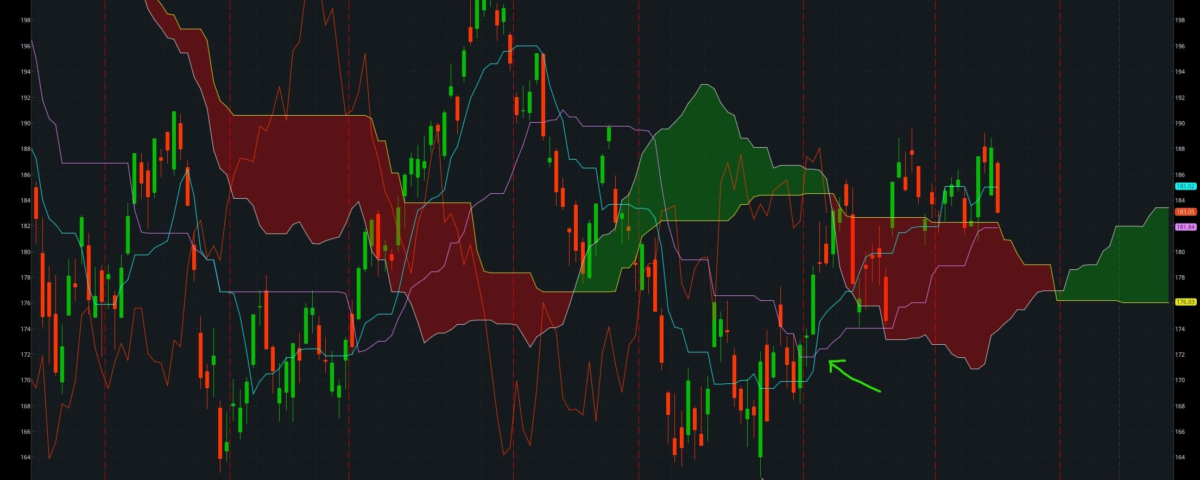What is the Ichimoku Cloud Technical Indicator?

The Denodo Data Architecture Singapore Conference
September 6, 2023
Connecting the Connectivity Ecosystem at Mobile World Congress 2024
November 6, 2023The Ichimoku cloud is a technical indicator that defines support and resistance levels, gauges momentum and provides possible trading signals. It is a complex indicator that takes multiple variables into account.
The chart is based on the Tenkan and Kijun Sen, with a cross of either indicating a potential trend change. It also includes the Chikou span, a light green lagging line. The height and shape of the cloud or komo alters over time, influencing future support and resistance levels.
Trend direction
The Ichimoku Cloud is a powerful indicator that is effective for usage over different charting time frames. It consists of five lines that can give traders a clear overview of the price chart and identify potential trading signals. Traders should understand how the indicator works and its different parts before using it in their trading strategies.
The indicator consists of two unique moving averages and a lagging closing price line. The Tenkan-sen (conversion line) is a 9-period moving average while the Kijun-sen (base line) is a 26-period moving average. The Moving Averages are then combined to create the Ichimoku cloud. The leading span A is the mid-point between the conversion and base lines and is projected 26 periods into the future while the lagging span is the closing price pushed back 26 periods.
When the trigger crosses above the base line, it suggests that a price is in an uptrend while a cross below the base line indicates a down trend. The Ichimoku cloud also identifies support and resistance levels.
Momentum
The ichimoku cloud is an indicator that defines support and resistance levels, gauges momentum, and generates trading signals. It takes multiple trading averages and uses them to calculate a “cloud” that attempts to forecast where the price may find support or resistance in the future. It is often used in conjunction with other indicators to maximize risk-adjusted returns.
The two lines that make up the ichimoku cloud (the Conversion line and the Base line) provide important information on the momentum of the market. If the Conversion line crosses above the Base line, it indicates that price momentum is bullish, which is a good indication of a positive trend.
In addition, the chikou span serves as levels of support and resistance. A thick cloud implies high volatility, while a thin cloud indicates low volatility. The ichimoku cloud can also help traders determine if a trade is going to be profitable. Buy signals are generated when the price rises above the cloud, and sell signals are generated when prices fall below the cloud.
Relative strength index
The Ichimoku Cloud indicator consists of five leading and lagging indicators that help traders identify potential trend reversal zones. It provides clear trading signals and is easy to use. However, it is best used with trending stocks rather than those that are not moving much. Otherwise, it will generate too many false signals.
The conversion line and base line act as lines of support and resistance and traders will receive a trading signal when prices break these levels. The Tenkan Sen and Kijun Sen also change colors based on the trend direction. A rise in the Tenkan Sen above the Kijun Sen is considered bullish while a fall below it is bearish. The Chikou Span line is also a key component as it lags behind the price and is plotted 26 periods backwards on a chart.
When the conversion line crosses above the base line, it suggests an asset is strengthening in the market and a long position could be profitable. A crossover below the base line, on the other hand, indicates weakness in the market and a short position could be profitable.
Trading signals
The Ichimoku cloud is a lagging indicator that confirms price movements and trend shifts. It is different from predictive indicators like the CCI and RSI, which try to help traders predict trends and market movements before they happen. Using the indicator in conjunction with other technical analysis tools can increase trading efficiency.
Traders should look for crossings between the conversion line and base line to identify potential trading opportunities. These crosses are often more frequent than crossovers between the Kijun-Sen and Tenkan-Sen. The Chikou span, which is the closing price plotted 26 periods backwards on the chart, can also confirm trend direction. A Chikou span above the price suggests a bullish trend, while a Chikou span below the price indicates a bearish trend.
Ichimoku Cloud is a technical indicator that helps traders understand the market at a glance. It uses formulas to project support and resistance levels on a chart, as well as to identify trend direction. Its colors change based on the trend direction. For example, when Leading Span A is above Leading Span B, it signals an uptrend and the space between the lines is colored green.


